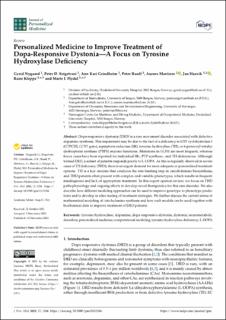| dc.contributor.author | Nygaard, Gyrid | |
| dc.contributor.author | Szigetvari, Peter D. | |
| dc.contributor.author | Grindheim, Ann Kari | |
| dc.contributor.author | Ruoff, Peter | |
| dc.contributor.author | Martinez, Aurora | |
| dc.contributor.author | Haavik, Jan | |
| dc.contributor.author | Kleppe, Rune | |
| dc.contributor.author | Flydal, Marte I. | |
| dc.date.accessioned | 2021-12-07T10:25:48Z | |
| dc.date.available | 2021-12-07T10:25:48Z | |
| dc.date.created | 2021-12-02T14:26:56Z | |
| dc.date.issued | 2021-11 | |
| dc.identifier.citation | Nygaard, G., Szigetvari, P.D., Grindheim, A.K., Ruoff, P., Martinez, A., Haavik, J., Kleppe, R., & Flydal, M.I. (2021) Personalized medicine to improve treatment of dopa-responsive dystonia—a focus on tyrosine hydroxylase deficiency. Journal of Personalized Medicine, 11 (11), article 1186. | en_US |
| dc.identifier.issn | 2075-4426 | |
| dc.identifier.uri | https://hdl.handle.net/11250/2833089 | |
| dc.description.abstract | Dopa-responsive dystonia (DRD) is a rare movement disorder associated with defective dopamine synthesis. This impairment may be due to the fact of a deficiency in GTP cyclohydrolase I (GTPCHI, GCH1 gene), sepiapterin reductase (SR), tyrosine hydroxylase (TH), or 6-pyruvoyl tetrahydrobiopterin synthase (PTPS) enzyme functions. Mutations in GCH1 are most frequent, whereas fewer cases have been reported for individual SR-, PTP synthase-, and TH deficiencies. Although termed DRD, a subset of patients responds poorly to L-DOPA. As this is regularly observed in severe cases of TH deficiency (THD), there is an urgent demand for more adequate or personalized treatment options. TH is a key enzyme that catalyzes the rate-limiting step in catecholamine biosynthesis, and THD patients often present with complex and variable phenotypes, which results in frequent misdiagnosis and lack of appropriate treatment. In this expert opinion review, we focus on THD pathophysiology and ongoing efforts to develop novel therapeutics for this rare disorder. We also describe how different modeling approaches can be used to improve genotype to phenotype predictions and to develop in silico testing of treatment strategies. We further discuss the current status of mathematical modeling of catecholamine synthesis and how such models can be used together with biochemical data to improve treatment of DRD patients. | en_US |
| dc.language.iso | eng | en_US |
| dc.publisher | MDPI | en_US |
| dc.rights | Navngivelse 4.0 Internasjonal | * |
| dc.rights.uri | http://creativecommons.org/licenses/by/4.0/deed.no | * |
| dc.subject | dopamin | en_US |
| dc.subject | tyrosine hydroxylase | en_US |
| dc.subject | dystoni | en_US |
| dc.subject | nevrometaboliske tilstander | en_US |
| dc.title | Personalized medicine to improve treatment of dopa-responsive dystonia—a focus on tyrosine hydroxylase deficiency | en_US |
| dc.type | Peer reviewed | en_US |
| dc.type | Journal article | en_US |
| dc.description.version | publishedVersion | en_US |
| dc.rights.holder | © 2021 by the authors | en_US |
| dc.subject.nsi | VDP::Medisinske Fag: 700::Klinisk medisinske fag: 750 | en_US |
| dc.source.volume | 11 | en_US |
| dc.source.journal | Journal of Personalized Medicine | en_US |
| dc.source.issue | 11 | en_US |
| dc.identifier.doi | 10.3390/jpm11111186 | |
| dc.identifier.cristin | 1963524 | |
| dc.source.articlenumber | 1186 | en_US |
| cristin.ispublished | true | |
| cristin.fulltext | original | |
| cristin.qualitycode | 1 | |

